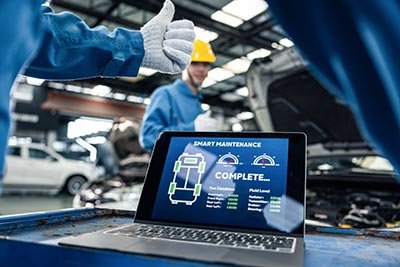
Did you know auto repair shops using estimate software can increase their efficiency by up to 30%? It highlights how transformative technology can be in today’s auto repair industry. Customers expect quick, accurate estimates, and having the right software is necessary. Auto repair estimate software lets shop owners and staff generate precise quotes. This saves time and enhances customer satisfaction. Yet, proper training is essential to unlock the software’s potential. Investing time in educating your team will maximize the software’s benefits. With the right training, your staff will be empowered to use the software effectively. It will ensure your shop thrives in a competitive market.
The Evolution of Auto Repair Estimate Software
The journey of auto repair estimating software began in the late 20th century. Shops relied heavily on manual calculations and paper estimates. Technicians would spend hours jotting down costs for parts and labor.
This process caused errors and miscommunication with customers. As the automotive industry evolved, so did the need for efficiency and accuracy. In the early 2000s, estimate software offered features that digitized the estimating process.
These early systems simplified calculations and helped standardize pricing. Over the years, as technology advanced, so did these tools. They transitioned from basic desktop applications to more sophisticated solutions.
Today, estimate software is critical to any successful shop. It saves time, improves accuracy, and enhances the customer experience.
Current Trends
As technology continues to advance, so do the features and capabilities of software. Here are some of the latest trends shaping the industry:
Integration with Inventory Management
Automotive repair estimate software can connect with inventory systems. It allows shop owners to track parts in real-time. This integration ensures that estimates reflect current stock levels. It also reduces the risk of delays or unexpected costs for customers.
Mobile Access
Many software providers now offer mobile-friendly versions of their platforms. Technicians can create estimates on the shop floor using tablets or smartphones. This convenience allows for immediate adjustments based on customer feedback.
Cloud-Based Solutions
Cloud technology is becoming the norm. It allows shop owners to access their estimate software from anywhere. This flexibility is particularly beneficial for multi-location businesses to track operations remotely.
Enhanced Reporting and Analytics
The software includes robust reporting tools that provide insights into shop performance. These analytics can help owners:
- Identify trends
- Track profitability
- Make informed business decisions based on real data
Customer Portal Features
The software includes customer portals where clients can:
- View estimates
- Approve work
- Track the status of their vehicles
This transparency fosters trust and improves customer engagement.
The Benefits of Using Estimate Software
Here are the benefits of using the estimate software:
Accuracy and Efficiency
Automotive repair estimating software can enhance accuracy and efficiency significantly. When technicians input data, the software calculates costs using a pre-set formula. This reduces human error, which can occur during manual calculations.
Mistakes in estimates can lead to happier customers and financial losses. The software mitigates this risk by providing consistent, accurate quotes every time. Additionally, the speed of the estimating process is greatly improved.
With a few clicks, technicians can generate comprehensive estimates that include:
- Parts
- Labor
- Extra services
This swift turnaround allows shops to provide estimates to customers almost instantly. It enhances the customer experience and helps to close sales more quickly.
Customer Transparency
In today’s market, transparency is key to building trust with customers. The software allows repair shops to create itemized estimates outlining each service’s costs. Customers feel more informed and valued When they see what they’re paying for.
These details foster trust and encourage customers to engage with the process. If they understand the breakdown, they will approve the estimate without hesitation. This transparency leads to higher customer satisfaction and encourages repeat business.
Time Management
Time is money in the auto repair industry. The software helps shops maximize their time management. By streamlining the process, staff can spend less time on paperwork and more time on repairs.
The software reduces the need for back-and-forth communication about costs and services. Shop owners can keep track of operations with integrated systems that connect:
- Estimating
- Invoicing
- Inventory management
This integration minimizes the chances of double work. It ensures that the entire team is on the same page. Ultimately, this time saved translates into increased productivity and profitability for the shop.
The Importance of Proper Training
To maximize the benefits of software, staff must be well-versed in its key features. Here are some critical functionalities they need to understand:
Estimating
Staff should be trained on how to create accurate estimates quickly. This includes:
- Knowing how to input data
- Access parts databases
- Apply labor rates effectively
- Understanding how to customize estimates
Invoicing
Familiarity with the invoicing process is crucial. Employees need to know:
- How to convert estimates into invoices
- Track payments
- Manage customer accounts
This ensures smooth financial transactions and minimizes errors.
Reporting
The ability to generate reports can provide valuable insights into shop performance. Training staff can help shop owners make informed decisions to improve their business. They should be trained on how to use reporting tools to:
- Analyze sales
- Customer preferences
- Service trends
Hands-On Experience
Interactive training sessions are far more effective than passive learning methods. Hands-on experience allows staff to engage directly with the software. Here’s why it’s beneficial:
Real-World Application
Real scenarios help employees see how to apply their knowledge in daily operations. This makes them better prepared to handle actual customer interactions and estimates.
Immediate Feedback
During interactive sessions, trainers can provide immediate feedback and answer questions. This fosters a supportive learning environment and addresses any confusion right away.
Team Collaboration
Training together encourages teamwork and collaboration. Employees can learn from one another and share tips, enhancing shop morale.
Creating a Knowledge Base
To ensure ongoing success, developing a knowledge base is vital. This can include:
Manuals and Guides
Create user-friendly manuals to outline the software’s most important features. These resources can serve as a go-to for staff when they encounter challenges.
FAQs and Troubleshooting Tips
Compile a list of frequently asked questions and common troubleshooting tips. This can empower staff to solve issues independently, reducing downtime.
Regular Updates
The knowledge base should be updated as new software features are introduced. This will ensure that all staff can fully use the software’s capabilities.
Maximizing Software Use
Here are some tips on how to maximize the software use:
Feedback Loops
Creating effective feedback loops is essential for maximizing the use of the software. Here’s how to establish channels for staff input:
Regular Meetings
Schedule regular team meetings where staff can discuss their experiences with the software. Encourage open dialogue about what works well and what challenges they face. This can foster a culture of collaboration and continuous improvement.
Suggestion Boxes
Set up a suggestion box where employees can anonymously submit their concerns. This will allow you to uncover insights that may surface outside of group discussions.
Surveys and Polls
Conduct periodic surveys to gather structured feedback on specific features of the software. Use this data to identify enhancement areas and focus on training needs.
Response Actions
Make sure to communicate any changes or improvements made based on staff feedback. Recognizing their input boosts morale and shows that their opinions are valued.
Customizing Software
Tailor the auto estimating software settings to fit your shop’s specific needs. It can significantly enhance its effectiveness. Here are some customization tips:
Setting User Permissions
Customize user roles and permissions to ensure staff access only the relevant features. This simplifies the user interface and reduces confusion.
Configuring Templates
Take advantage of customizable templates for estimates and invoices. Tailoring these to reflect your shop’s branding and typical services. It can save time and create a professional appearance.
Integrating with Other Tools
Ensure the software integrates with other software (like accounting or inventory management systems). This streamlines processes and improves data accuracy.
Adjusting Pricing Models
Regularly review and update pricing models within the software to reflect the following:
- Current market rates
- Labor costs
- Supplier prices
This ensures that estimates remain competitive and profitable.
Analyzing Data
Utilizing software-generated reports can provide valuable insights for strategic decision-making. Here’s how to encourage this practice:
Regular Review of Reports
Schedule time for staff to review reports on key performance indicators (KPIs) such as:
- Sales trends
- Customer demographics
- Service profitability
Discuss these findings in team meetings to make data-driven decisions.
Setting Goals Based on Data
Use insights from reports to set specific, measurable goals for the team. Data can help guide your objectives for:
- Increasing the number of estimates converted to sales
- Reducing turnaround time
Identifying Training Needs
Analyze data to identify areas where extra training may be needed. Staff need more training on certain services that are frequently revised.
Tracking Customer Feedback
Encourage staff to track customer feedback through the software. Use this data to identify trends in customer satisfaction and address any issues.
Conclusion
Leveraging the full potential of auto repair estimate software is essential for success. This journey begins with effective training. Shop owners can enhance efficiency and accuracy by ensuring staff understand key features. Feedback loops and customization further empower teams to adapt the software. At the same time, data analysis enables informed decision-making that drives growth. Investing in training and software upgrades is a smart choice for a shop owner. It’s a crucial step toward staying competitive in an ever-evolving industry. The success of an auto repair shop hinges on technology and skilled individuals.
Also ReaD: 5 Tips On Choosing The Best Pest Control Services



